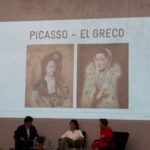Pablo Picasso (1881-1973) wrote Yo-Greco (I El Greco) and El Greco Vélazquez inspirarme (El Greco Velázquez inspire me) on his first drawings after viewing works by these old masters in the Museo del Prado.
Picasso was studying at the art academy in Madrid and discovered his artistic partners for life. He remained, in his own words, in permanent dialogue with these masters throughout his career.
El Greco
El Greco (Doménikos Theotokópoulos, 1541-1614) was soon forgotten after his death, although he had been a successful painter. As the name suggests, he was of Greek origin (Crete), when Venice ruled the island. Byzantine art and icons were his sources of inspiration. El Greco left for Venice in 1567. There he came into contact with Titian (1490-1576), Tintoretto (1518-1594) and other masters.
He settled in Rome in 1572 and got in touch with Spanish artists. In Rome, he became acquainted with the artistic inspiration of the Council of Trent (1543-1563) and its Baroque and Mannerism soon afterwards.
In 1577, he moved to the court of the Spanish King Philip II (1527-1598) and his new palace El Escorial in Madrid. However, El Greco did not receive the commissions and recognition he expected, and he left for Toledo, where he settled as a free artist. This position allowed him to develop his style.
Picasso
At the end of the nineteenth century, artists and art dealers rediscovered his qualities as a ‘modern’ artist in terms of composition and colours. For Picasso, he was the founder of Cubism, which Picasso subsequently gave a place in art history through his Les Demoiselles d’Avignon (1907).
El Greco and Picasso
The exhibition (Picasso – El Greco) shows the intense artistic attention of Picasso for El Greco. Picasso did not call it an imitation but a dialogue. Diego Velázquez (1599-1660) and Rembrandt van Rijn (1606-1669) also belonged to his ‘conversation group’. In 1967, Picasso expressed this commitment on the back of his ‘The Musketeer’. He wrote on the backside Doménikos Theotokópoulos van Rijn Da Silva (Velázquez).
Paloma Picasso was also present at the press conference preceding the show’s opening. She confirmed this lifelong relationship. For her father, Picasso, there was no time difference. An old master from 350 years ago was as much present and a part of the dialogue as contemporaries such as Henri Mattise (1869-1954), Paul Cézanne (1839-1906) or, for example Georges Braque (1882-1963).
The relationship between El Greco and Picasso is not new. The Kunstmuseum Basel, however, presents the lifelong ‘dialogue’ in words, drawings, paintings and a catalogue. Both masters are at the centre of the attention, as if there were no centuries between them, just as Picasso saw it.
The exhibition starts appropriately with Picasso’s first drawings and their references to the old masters. Twelve works of Picasso from the Kunstmuseum Basel and around sixty masterpieces by the two artists from museums in New York, Madrid, Barcelona, London, Budapest, Washington, Paris, Toledo and Berlin present their relationship comparatively. Exceptional is the presence of masterpieces from churches in Toledo.
Picasso and Basel
Picasso has a unique, even affective relationship with Basel. Inhabitants of the city organised a referendum in 1967 to save two paintings (Two Brothers and the Seated Harlequin) for the Kunstmuseum Basel.
The owner and lender, in need of money, wanted to sell them for CHF 6 million. The population voted in a referendum with an overwhelming majority to buy ‘their two Pablo’s’. Picasso was very touched by this spirit and donated four paintings to the museum.
As part of one of the oldest public art collections in the world and in view of its capacity and commitment to organise great exhibitions and to involve the citizens of Basel, the Kunstmuseum Basel can write Yo Kunstmuseum Basel on its façade.



